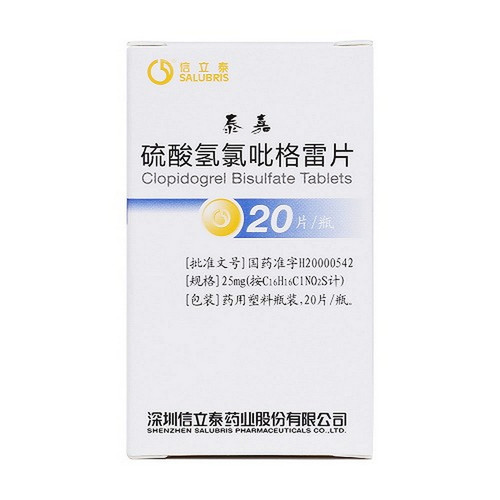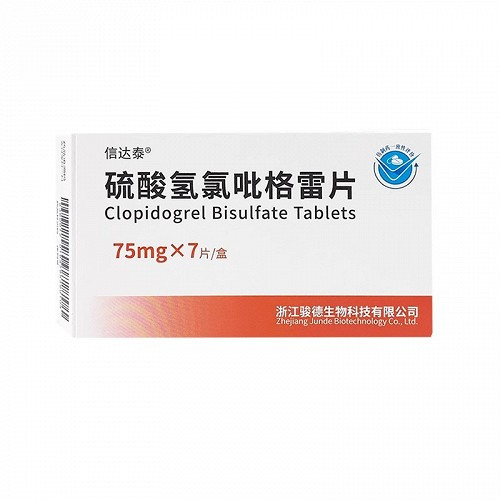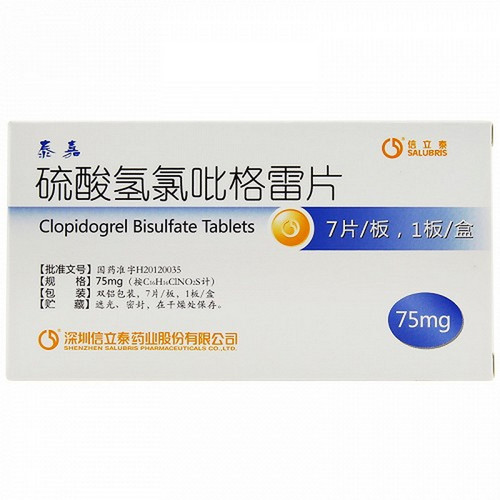Product Overview
[Drug Name]
Generic Name: Clopidogrel Bisulfate Tablets
Trade Name: Shuaitai Clopidogrel Bisulfate Tablets (Film-Coated) 25mg x 10 tablets x 2 plates
[Main Ingredients]
The main ingredient of this product is clopidogrel bisulfate, chemically known as S(+)-2-(2-chlorophenyl)-2-(6,7-dihydrothieno[3,2-c]pyridin-5-yl)acetate methyl hydrogen sulfate. Molecular Formula: C₁₆H₁₆CINO₂S·H₂SO₄ Molecular Weight: 419.9
[Properties]
This product is a white or off-white tablet or film-coated tablet. After removal of the coating, it appears white or off-white.
[Indications/Main Functions]
Clopidogrel is indicated for the prevention of atherothrombotic events in the following patients: patients with a recent myocardial infarction (from a few days to less than 35 days), patients with a recent ischemic stroke (from 7 days to less than 6 months), or patients with established peripheral arterial disease. Acute Coronary Syndrome Patients - Non-ST-segment Elevation Acute Coronary Syndrome (including unstable angina or non-Q-wave myocardial infarction), including patients undergoing percutaneous coronary intervention with stent implantation, in combination with aspirin. - For use in patients with ST-segment Elevation Acute Coronary Syndrome, in combination with aspirin, and may be used in conjunction with thrombolytic therapy.
[Specifications]
25mg*20 tablets (film-coated)
[Dosage and Administration]
The recommended dose of clopidogrel bisulfate tablets for adults and the elderly is 75mg once daily, taken with or without food. For Acute Coronary Syndrome Patients: - Patients with Non-ST-segment Elevation Acute Coronary Syndrome (unstable angina or non-Q-wave myocardial infarction) should start with a single loading dose of clopidogrel 300mg (in combination with aspirin 75mg-325mg/day), followed by a continuous dose of 75mg once daily. Because higher doses of aspirin are associated with a higher risk of bleeding, the recommended daily maintenance dose of aspirin should not exceed 100 mg. While the optimal dose has not yet been formally established, clinical trial data support 12 months of treatment, with maximal efficacy observed after three months. For ST-segment elevation acute myocardial infarction: Clopidogrel should be initiated with a loading dose, followed by 75 mg once daily, with or without aspirin, with or without a thrombolytic agent. For patients over 75 years of age, a loading dose of clopidogrel should not be used. Combination therapy should be initiated as soon as possible after symptom onset and continued for at least four weeks. No studies have demonstrated the benefit of combined clopidogrel and aspirin treatment beyond four weeks. For patients with recent myocardial infarction (from a few days to less than 35 days), recent ischemic stroke (from seven days to less than six months), or established peripheral arterial disease, the recommended dose is 75 mg daily. If a dose is missed: If the dose is missed within 12 hours of the regularly scheduled dose, the patient should take a standard dose immediately and the next dose at the regularly scheduled time. If the dose is missed more than 12 hours after the regularly scheduled dose, the patient should take the standard dose at the next regularly scheduled time without doubling the dose. Renal Impairment: There is limited experience in patients with renal impairment. Hepatic Impairment: There is limited experience in patients with moderate hepatic impairment who have a bleeding tendency.
[Adverse Reactions]
The safety of clopidogrel has been evaluated in over 42,000 patients, including 9,000 patients treated for at least one year. Clinically relevant adverse reactions observed in CAPRIE, CURE, CLARITY, and COMMIT are discussed below. In the CAPRIE study, clopidogrel 75 mg/day was better tolerated than aspirin 325 mg/day. In this study, the overall tolerability of clopidogrel was similar to that of aspirin, regardless of age, gender, or race. In addition to clinical research experience and spontaneous reports of adverse reactions, bleeding was the most common adverse reaction in clinical studies and postmarketing reports, often reported within the first month of treatment. In the CAPRIE study, the overall incidence of bleeding events was 9.3% for patients receiving clopidogrel or aspirin, and the incidence of serious events with clopidogrel was similar to that with aspirin. In the CURE study, patients who discontinued clopidogrel for more than five days before surgery experienced fewer major bleeding events within seven days of coronary artery bypass grafting. For patients who continued treatment for five days after bypass grafting, the event rates were 9.6% and 6.3% for clopidogrel plus aspirin and placebo plus aspirin, respectively. In the CLARITY study, bleeding was increased in the clopidogrel plus aspirin group compared with the placebo plus aspirin group. The incidence of major bleeding was similar between the two groups. The patterns were consistent across subgroups defined by baseline characteristics, fibrinolytic type, or heparin treatment. In the COMMIT study, the overall rates of intracranial hemorrhage and non-intracranial major hemorrhage were low and similar in both groups. Adverse reactions reported in clinical studies and spontaneously are listed in the table below. The incidence of adverse reactions is defined as: common (≥1/100, <1/10); uncommon (>1/1,000, <1/100); rare (≥1/10,000, <1/1,000); and very rare (<1/10,000). Within each organ system group, adverse reactions are ranked in descending order of severity. Adverse reactions occur in system organ classification 1. Blood and lymphatic system disorders Uncommon: thrombocytopenia, leukopenia, eosinophilia Rare: neutropenia, including severe neutropenia Very rare: thrombotic thrombocytopenic purpura (TTP), aplastic anemia, pancytopenia, agranulocytosis, severe thrombocytopenia, granulocytopenia, anemia 2. Immune system disorders Very rare: serum sickness, allergic reaction 3. Psychiatric disorders Very rare: hallucinations, confusion 4. Nervous system disorders Uncommon: intracranial hemorrhage (reported fatal), headache, paresthesia, dizziness Very rare: taste disorder 5. Eye disorders Uncommon: Eye hemorrhage (conjunctival, ocular, retinal). 6. Ear and labyrinth disorders. Rare: Vertigo. 7. Vascular disorders. Common: Hematoma. Very rare: Severe bleeding, surgical wound bleeding, vasculitis, hypotension. 8. Respiratory, thoracic, and mediastinal disorders. Common: Epistaxis. Very rare: Respiratory bleeding (hemoptysis, pulmonary hemorrhage), bronchospasm, interstitial pneumonia. 9. Gastrointestinal disorders. Common: Gastrointestinal bleeding, diarrhea, abdominal pain, dyspepsia. Uncommon: Gastric and duodenal ulcers, gastritis, vomiting, nausea, constipation, flatulence. Rare: Retropleural hemorrhage. Very rare: Fatal gastrointestinal and retroperitoneal hemorrhage, pancreatitis, colitis (including ulcerative or lymphocytic colitis), stomatitis. 10. Hepatobiliary disorders. Very rare: Acute liver failure, hepatitis, abnormal liver function tests. 11. Skin and subcutaneous tissue disorders. Common: Bruising. Uncommon: Rash, pruritus, skin hemorrhage (purpura). Very rare: Bullous dermatitis (toxic epidermal necrolysis, Stevens' disease). Johnson syndrome, erythema multiforme), angiohematoma, erythematous rash, lichen planus 12. Skeletal muscle, connective tissue, and bone disorders Very rare: Skeletal muscle bleeding (hemarthrosis), arthritis, arthralgia, myalgia 13. Renal and urinary tract disorders Uncommon: Hematuria Very rare: Glomerulonephritis, increased serum creatinine 14. General conditions Common: Surgical wound bleeding Very rare: Fever
[Contraindications]
1. Hypersensitivity to the active substance or any component of this product. 2. Severe liver damage. 3. Active pathological bleeding, such as peptic ulcer or internal bleeding.
[Drug Interactions]
Oral anticoagulants: Due to the potential for exacerbating bleeding, the concomitant use of clopidogrel with oral anticoagulants is not recommended. Although a daily dose of 75 mg clopidogrel does not alter the pharmacokinetics or international normalized ratio of S-warfarin in patients receiving long-term warfarin therapy, the combined use of warfarin and clopidogrel increases the risk of bleeding due to their independent inhibition of hemostasis. Glycoprotein III/Glycoprotein IIa antagonists: Caution should be exercised in the concomitant use of clopidogrel and glycoprotein III/Glycoprotein IIa antagonists. Acetylsalicylic acid (aspirin): Aspirin does not alter the inhibitory effect of clopidogrel on ADP-induced platelet aggregation, but clopidogrel enhances aspirin's inhibitory effect on collagen-induced platelet aggregation. However, the combined use of aspirin 500 mg twice a day for one day does not significantly increase the prolonged bleeding time caused by clopidogrel. There may be a pharmacodynamic interaction between clopidogrel and aspirin, which increases the risk of bleeding. Therefore, care should be taken when the two drugs are used together (see Precautions. However, there have been patients who have used clopidogrel and aspirin together for more than one year (see Pharmacological Properties). Heparin: Studies conducted in healthy volunteers have shown that clopidogrel does not change the effect of heparin on coagulation. There is no need to change the dose of heparin. The combined use of heparin does not affect the inhibitory effect of clopidogrel on platelet aggregation. There may be a pharmacodynamic interaction between clopidogrel and heparin, which increases the risk of bleeding. Therefore, care should be taken when the two drugs are used together (see Precautions. Thrombolytic drugs: In patients with acute myocardial infarction, the safety of clopidogrel combined with fibrin-specific or non-specific thrombolytics and heparin was evaluated, and the incidence of clinical bleeding was compared with that of fibrin-specific thrombolytics. The effects of combined use of suppositories, heparin, and aspirin are similar. (See [Adverse Reactions]) Nonsteroidal anti-inflammatory drugs (NSAIDs): In a clinical trial conducted in healthy volunteers, the concomitant use of clopidogrel and naproxen increased occult gastrointestinal bleeding. Due to the lack of studies on the interaction between clopidogrel and other NSAIDs, it is unclear whether the concomitant use of all NSAIDs increases the risk of gastrointestinal bleeding. Therefore, caution should be exercised when co-administering NSAIDs, including Cox-2 inhibitors, with clopidogrel (see Precautions). Other concomitant therapies: Because clopidogrel is partially metabolized by CYP2C19 to its active metabolite, the use of drugs that inhibit this enzyme may result in clopidogrel. Reduction in the level of active metabolites. The clinical relevance of drug interactions is not yet determined. Co-administration of strong or moderate CYP2C19 inhibitors (such as omeprazole) is not recommended (see [Precautions] and [Pharmacokinetics]). Drugs that inhibit CYP2C19 include omeprazole, esomeprazole, fluvoxamine, fluoxetine, mofloxacin, voriconazole, fluconazole, clopidogrel, ciprofloxacin, cimetidine, carbazepine, oxcarbazepine, and chloramphenicol. Proton pump inhibitors (PP): Omeprazole 80 mg once daily, taken with clopidogrel or taken 12 hours apart, reduces the blood concentration of clopidogrel's active metabolite by 45% (loading dose) and 40% (maintenance dose) This decrease in blood concentration can lead to a 39% decrease in platelet aggregation inhibition (loading dose) and a 21% decrease in platelet aggregation inhibition (maintenance dose). Esomeprazole and clopidogrel may interact similarly. Regarding the impact of pharmacokinetic (PK/pharmacodynamic (PD)) interactions on clinical outcomes such as major cardiovascular events, observational and clinical studies have shown inconsistent results. The combined use of clopidogrel with omeprazole or esomeprazole is not recommended (see [Precautions]). No significant decrease in the blood concentration of clopidogrel metabolites was observed after the combined use of clopidogrel with omeprazole, lansoprazole, and clopidogrel. Furthermore, the combined use of 80 mg of omeprazole once daily with clopidogrel has been shown to reduce the plasma concentration of clopidogrel's active metabolite. The platelet aggregation inhibition rate decreased by 20% (loading dose) and 14% (maintenance dose), respectively, and was accompanied by a decrease of 15% and 11% in the mean platelet aggregation inhibition rate, respectively. These results suggest that clopidogrel can be co-administered with phentolamine. There is no evidence that other drugs that inhibit gastric acid secretion, such as H2 blockers (excluding the CYP2C19 inhibitor cimetidine) or antacids, interfere with the antiplatelet activity of clopidogrel. Other drugs: Through a large number of other clinical studies, the pharmacodynamic and pharmacokinetic interactions of clopidogrel with other concomitant drugs were studied. No clinically significant pharmacodynamic interactions were found when clopidogrel was used alone or simultaneously with atenolol and nifedipine. In addition, clopidogrel and phentolamine The combined use of clopidogrel and estradiol has no significant effect on the pharmacodynamic activity of clopidogrel. Clopidogrel does not change the pharmacokinetics of digoxin or theophylline, and antacids do not change the absorption of clopidogrel. CAPRE study data show that phenytoin and tolbutamide can be safely used in combination with clopidogrel. In addition to the above-mentioned clear drug interaction information, the interaction between clopidogrel and commonly used drugs in patients with atherothrombotic diseases has been studied. However, in clinical trials, patients received a variety of concomitant drugs while taking clopidogrel, including diuretics, beta-blockers, ACEI calcium antagonists, lipid-lowering drugs, coronary vasodilators, antidiabetic drugs (including insulin), antiepileptic drugs, and GPIIb/I. α-receptor antagonists; no clinically significant adverse interactions have been identified.
[Precautions]
Bleeding and Hematologic Abnormalities: Due to the risk of bleeding and hematologic adverse reactions, if clinical symptoms of bleeding occur during treatment, a blood count and/or other appropriate tests should be immediately considered. As with other antiplatelet agents, clopidogrel should be used with caution in patients at increased risk of bleeding due to trauma, surgery, or other pathological conditions, and in patients receiving aspirin, nonsteroidal anti-inflammatory drugs (NSAIDS) including Cox-2 inhibitors, heparin, platelet glycoprotein α (GP11b) inhibitors, or thrombolytics. Patients should be closely followed. Be aware of bleeding, including occult bleeding. The combination of clopidogrel and warfarin is not recommended because it may worsen bleeding, especially during the first few weeks of treatment and/or after cardiac intervention or surgery. In patients who require elective surgery, if antiplatelet therapy is not necessary, clopidogrel should be discontinued 7 days prior to surgery. Before scheduling any surgery and before taking any new medications, patients should inform their doctors that they are taking clopidogrel (alone or in combination with aspirin). Bleeding may take longer than usual, and patients should report abnormal bleeding sites and bleeding times to their doctors. Discontinuation of medication: Interruption of treatment should be avoided. If clopidogrel must be discontinued, it should be resumed as soon as possible. Premature discontinuation of clopidogrel may increase the risk of cardiovascular events. Thrombotic thrombocytopenic purpura (TP) Thrombotic thrombocytopenic purpura (T) can rarely occur after the use of clopidogrel, sometimes after a short period of use (2 weeks). TTP can be life-threatening. It is characterized by thrombocytopenia, microangiopathic hemolytic anemia, accompanied by neurological manifestations, renal impairment or fever. TTP is a condition that requires emergency treatment, including plasma exchange. Recent ischemic stroke: In patients with a recent transient ischemic attack or ischemic stroke who are at higher risk of another ischemic event, the combination of aspirin and clopidogrel has not been shown to be more effective than clopidogrel alone, however, the risk of bleeding is increased. Due to lack of data, clopidogrel is not recommended within 7 days of the onset of acute ischemic stroke. Pharmacogenetics ... have a high risk of another ischemic event, the combination of aspirin and clopidogrel has not been shown to be more effective than clopidogrel alone, however, the risk of bleeding is increased. Due to lack of data, clopidogrel is not recommended within 7 days of the onset of acute ischemic stroke. In patients with CYP2C19 (CYP2C19) poor metabolizers, the blood concentration of clopidogrel's active metabolite is reduced at the recommended dose, resulting in reduced antiplatelet effect. Methods are available for testing patients' CYP2C19 genotypes. Because clopidogrel is partially metabolized to its active metabolite by CYP2C19, the use of drugs that inhibit this enzyme may reduce the conversion of clopidogrel to its active metabolite. The clinical relevance of drug interactions is uncertain, and concomitant use of strong or moderate CYP2C19 inhibitors is not recommended. Renal Impairment: There is limited experience with clopidogrel in patients with renal impairment; therefore, clopidogrel should be used with caution in these patients. Hepatic Impairment: Due to limited experience with clopidogrel in patients with moderate liver disease who may have a bleeding tendency, clopidogrel should be used with caution. No effects have been observed with clopidogrel use on driving or operating machinery.
[Pediatric Use]
There is no experience with clopidogrel in children; it is safe and effective in patients under 18 years of age. The efficacy of clopidogrel has not been established.
[Use in Elderly Patients]
See [Dosage and Administration].
[Overdose]
Overdose of clopidogrel may cause prolonged bleeding time and bleeding complications. If bleeding is observed, appropriate treatment should be initiated. No antidote has been found for the pharmacological activity of clopidogrel. If rapid correction of prolonged bleeding is required, platelet transfusion can reverse the effects of clopidogrel.
[Pharmacology and Toxicology]
Pharmacodynamic Properties: Therapeutic Classification: Platelet Aggregation Inhibitor, excluding heparin. ATC Number: BOIAC-04. Clopidogrel is a prodrug, and one of its metabolites is a platelet aggregation inhibitor. Clopidogrel must be metabolized by CYP450 enzymes to produce an active metabolite that inhibits platelet aggregation. Clopidogrel's active metabolite selectively inhibits the binding of adenosine diphosphate (ADP) to its platelet P2Y12 receptor and the subsequent ADP-mediated activation of the glycoprotein GPI1b/la complex, thereby inhibiting platelet aggregation. Due to binding, It is irreversible. The remaining lifespan of platelets exposed to clopidogrel (approximately 7-10 days) is affected, while the rate of recovery of normal platelet function is consistent with platelet turnover. By blocking the released ADP-induced platelet activation and aggregation pathway, platelet aggregation induced by agonists other than ADP can also be inhibited. Since active metabolites are formed by CYP450 enzymes, some CYP450 enzymes are polymorphic or inhibited by other drugs. Therefore, not all patients will obtain sufficient platelet inhibition. Clopidogrel 75 mg, repeated once daily administration, significantly inhibits ADP-induced platelet aggregation from the first day. The inhibitory effect gradually increases and reaches a steady state in 3-7 days. At steady state, the average inhibition level of 75 mg of clopidogrel per day is 40%-60%. Generally, platelet aggregation and bleeding time gradually return to baseline levels within 5 days after discontinuation of treatment. Toxicology studies: In preclinical studies in rats and baboons, the most common reaction was liver changes. These liver The changes in liver function are due to the drug's effects on hepatic metabolic enzymes. The dose was 25 times the exposure achieved in humans with 75 mg/day of clopidogrel. Clopidogrel has no effect on hepatic metabolic enzymes at therapeutic doses in humans. Very high doses of clopidogrel have been shown to affect gastric tolerance (gastritis, gastric ulcers, and/or vomiting) in rats and baboons. No evidence of carcinogenicity was found in rats given clopidogrel at doses up to 77 mg/day for 78 weeks and 104 weeks, respectively. This dose resulted in plasma concentrations 25 times greater than the recommended human dose (75 mg/day). A series of in vitro and in vivo studies have demonstrated that clopidogrel is not genotoxic. Clopidogrel had no effect on fertility in female or male rats and was not teratogenic in rats or rabbits. Clopidogrel administration to lactating rats slightly delayed pup development. Pharmacokinetic studies have shown that clopidogrel and/or its metabolites are excreted in breast milk; therefore, direct (mild toxicity) or indirect (unpleasant taste) effects of clopidogrel cannot be ruled out.








